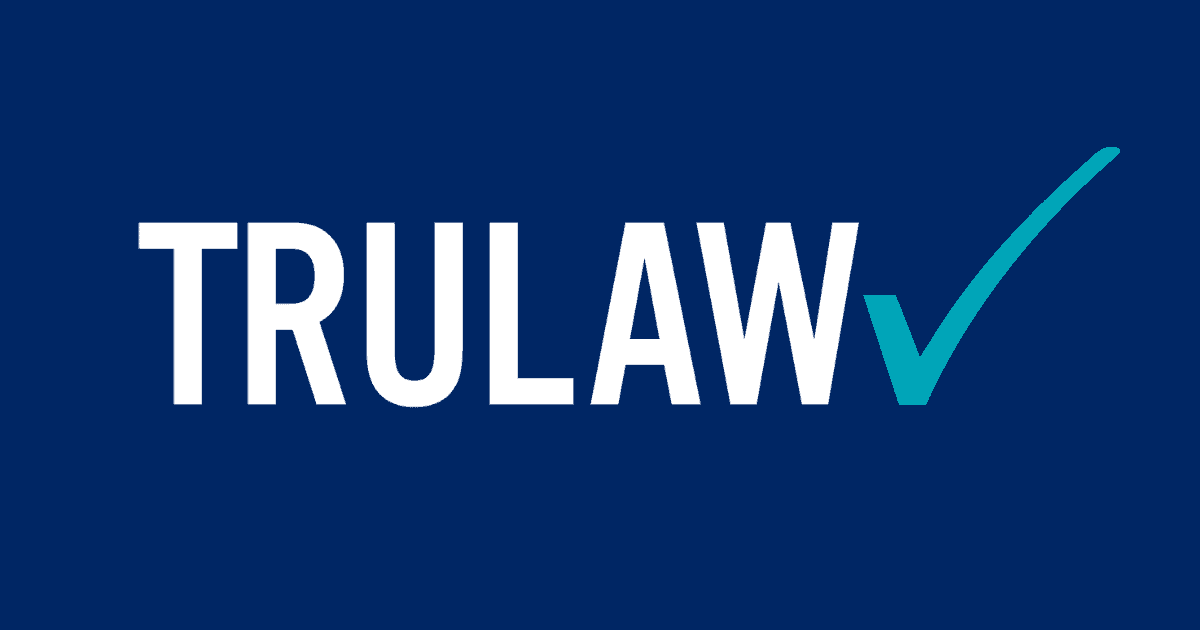Social Security Disability Insurance (SSDI)
- Last Updated: July 14th, 2025

Attorney Jessica Paluch-Hoerman, founder of TruLaw, has over 28 years of experience as a personal injury and mass tort attorney, and previously worked as an international tax attorney at Deloitte. Jessie collaborates with attorneys nationwide — enabling her to share reliable, up-to-date legal information with our readers.
Legally Reviewed
This article has been written and reviewed for legal accuracy and clarity by the team of writers and legal experts at TruLaw and is as accurate as possible. This content should not be taken as legal advice from an attorney. If you would like to learn more about our owner and experienced injury lawyer, Jessie Paluch, you can do so here.
Fact-Checked
TruLaw does everything possible to make sure the information in this article is up to date and accurate. If you need specific legal advice about your case, contact us by using the chat on the bottom of this page. This article should not be taken as advice from an attorney.
Key takeaways:
- Social Security Disability Insurance (SSDI) is a federal program that provides financial support to individuals who are unable to work due to a disabling medical condition.
- Understanding common SSDI acronyms and legal terms, such as SGA (Substantial Gainful Activity), SSI (Supplemental Security Income), and the role of the Appeals Council, is crucial for navigating the application and appeals processes effectively.
- SSDI benefits are calculated based on the applicant's past earnings, with most recipients receiving between $800 and $1,800 per month in 2024.
Overview of Social Security Disability Insurance (SSDI)
On this page, we’ll provide an overview of Social Security Disability Insurance (SSDI), SSDI definitions and legal terms, common SSDI mistakes to avoid, and much more.

Tips for Filing Your Social Security Disability Insurance (SSDI) Application
Individuals who have a medical condition that prevents them from working for at least 12 months or is expected to result in death should consider applying for SSDI.
Here are a few tips for filing your Social Security Disability Insurance application:
- Who Should Apply? Individuals unable to work due to a disability lasting at least 12 months should apply. Ensure you meet the SSA’s definition of disability and have enough work credits.
- What Is Needed? Gather medical records, work history, Social Security number, and any information about other benefits. Complete the application thoroughly to avoid delays.
- Where and When? Apply online, by phone, or at a local SSA office. File as soon as you’re unable to work to reduce wait times.
- Why Filing Correctly Matters: Mistakes or missing information can result in delays or denial. Filing accurately ensures a smoother process.
- How to Improve Approval Chances: Keep detailed medical records, fill out forms carefully, consider hiring a disability attorney, follow up regularly, and be prepared to appeal if denied.
Completing the application thoroughly and accurately will help prevent delays and may reduce the likelihood of denials due to missing information.
If you or a loved one has a mental or physical impairment preventing you from performing substantially gainful activity, you may qualify for compensation.
Contact TruLaw using the chat on this page to receive an instant case evaluation and determine your eligibility to file or appeal your SSDI benefits claim.
Table of Contents
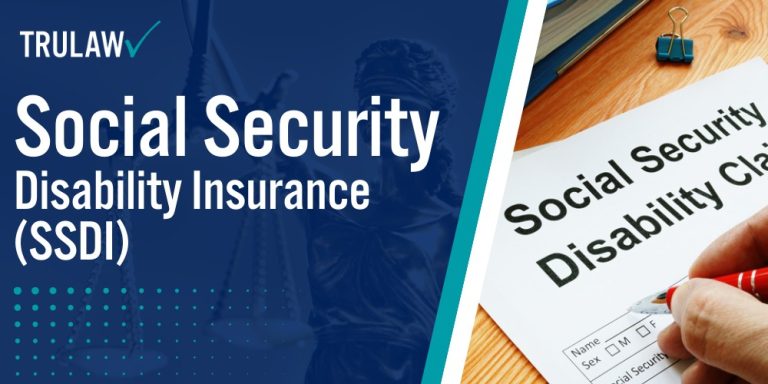
SSDI Definitions and Legal Terms
Social Security Disability Insurance (SSDI) is a federal program that provides financial support to individuals who are unable to work due to a disabling medical condition.
SSDI is part of the greater U.S. social safety net, which is funded by payroll taxes under the Federal Insurance Contributions Act (FICA).
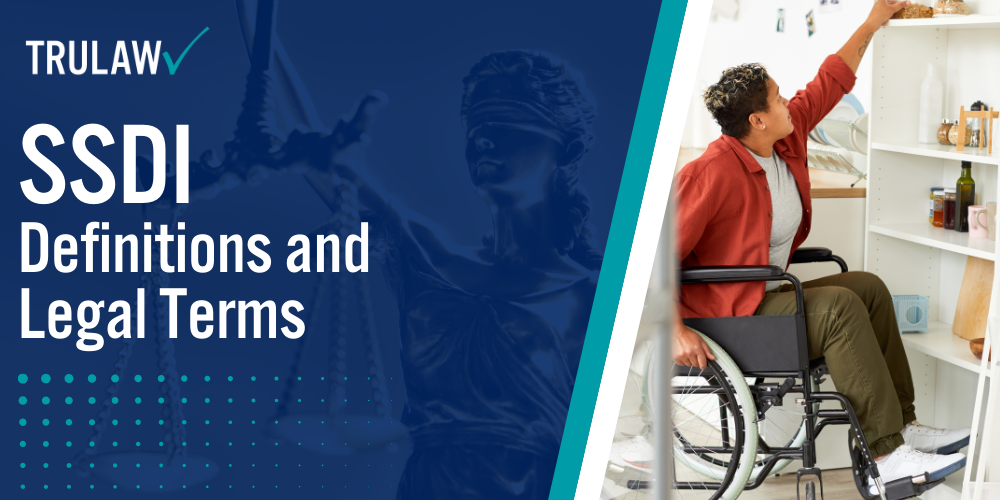
To be eligible for SSDI, an individual must meet specific criteria, which include a sufficient work history and payment of Social Security taxes on their earnings.
The program is designed to replace a portion of the income lost due to a disability that prevents substantial gainful activity.
Common SSDI Acronyms and Abbreviations
These terms represent key components of the SSDI program and are frequently used in official communications and eligibility determinations.
Familiarity with these acronyms can help applicants better understand their rights, responsibilities, and the steps involved in securing benefits.
Recognizing these abbreviations also facilitates more precise communication with legal representatives and Social Security Administration (SSA) officials.
Here are some of the standard terms used throughout the SSDI application process:
- SSDI (Social Security Disability Insurance): SSDI is a federal program offering financial support to disabled individuals who have paid into the Social Security system through their employment.
- SSI (Supplemental Security Income): SSI differs from SSDI in that it is a need-based program, assisting individuals with limited income and resources, regardless of their work history.
- Substantial Gainful Activity (SGA): Refers to the level of work activity and earnings considered by the SSA to be gainful employment. Earnings above a specific threshold may disqualify an individual from receiving SSDI benefits.
- Medically Determinable Physical or Mental Impairment: Physical or mental impairments that can be diagnosed by clinical and laboratory techniques. A mental impairment must be documented by acceptable medical evidence.
- Work Credits: The work credits required to qualify for SSDI are earned based on the individual’s earnings, with a maximum of four credits per year.
- AC (Appeals Council): The Appeals Council reviews decisions made by Administrative Law Judges (ALJs), offering claimants the opportunity to seek further review if they disagree with the initial ruling.
It is important to have a clear understanding of these terms and definitions to navigate the SSDI application process effectively.
Each term has specific legal implications that may impact eligibility, benefit calculations, and the overall outcome of a claim.
Knowing the difference between SSDI and SSI, for instance, helps applicants determine the appropriate program for their needs.
Additionally, understanding the appeals process and the role of the Appeals Council ensures that applicants are fully informed of their rights to contest unfavorable decisions.
SSDI Benefits
Social Security disability insurance provides disabled worker benefits to individuals and their families.
The amount you receive in SSDI benefits depends on your past earnings, with monthly payments ranging from $100 to $3,822 in 2024.
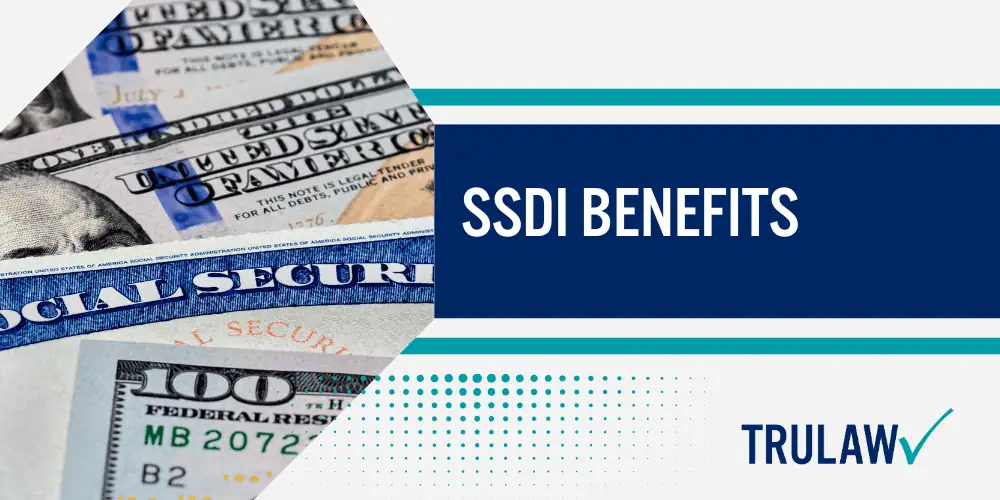
Most recipients receive between $800 and $1,800 per month, with the average monthly disability benefit being around $1,537.
In addition to monthly cash benefits, qualifying for SSDI also provides access to healthcare benefits through Medicare after a two-year waiting period.
SSDI Benefits and Medicare Health Insurance Coverage
While SSDI is not an income-based program, your benefit amount may be reduced if you are also receiving workers’ compensation or temporary state disability payments.
However, benefits from private disability insurance, veterans’ benefits, or Supplemental Security Income (SSI) do not affect your SSDI payment.
Social Security Disability Insurance (SSDI) and Medicare are interconnected programs that provide support for individuals with disabilities in the United States.
SSDI offers financial assistance, while Medicare provides health insurance coverage.
The relationship between these two programs involves specific timelines and eligibility requirements that beneficiaries must be aware of to maximize their benefits.
The key aspects of SSDI and Medicare integration include:
- 24-month waiting period for Medicare coverage
- Automatic enrollment in Medicare after the waiting period
- Access to various Medicare coverage options
- Special circumstances that may affect eligibility
- Healthcare alternatives during the waiting period
SSDI recipients gain access to Medicare coverage after a mandatory 24-month waiting period from the date they become eligible for SSDI benefits.
This waiting period can present challenges for individuals who require immediate medical care.
Once the waiting period concludes, beneficiaries are automatically enrolled in Medicare, which provides them with comprehensive health insurance coverage.
It is also important to note that certain conditions, such as End-Stage Renal Disease (ESRD), may qualify individuals for Medicare coverage without the typical waiting period, offering expedited access to necessary medical care.
SSDI Eligibility Criteria
To qualify for the SSDI program, you must meet specific work and medical requirements.
First, you need to have a sufficient work history in jobs where you paid Social Security taxes.
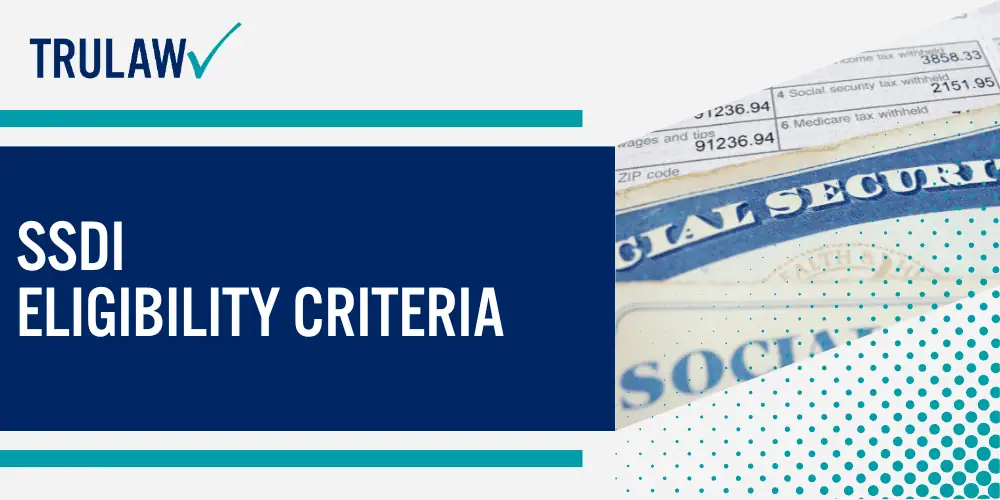
In addition to your work history, you must also have a medical condition that prevents you from working.
Meeting these criteria demonstrates both a contribution to the Social Security system and a legitimate need for disability benefits.
SSDI Eligibility: Work Requirements
The number of work credits required to qualify for SSDI benefits varies based on your age at the time of disability, annual income, and the amount of Social Security taxes you’ve paid.
You can earn one work credit for every $1,730 in wages or self-employment income, up to a maximum of four work credits per year.
Only earnings subject to Social Security taxes are considered when calculating these credits.
For example, if you become disabled at age 50, you generally need 28 work credits, which equates to about seven years of work, with at least five of those years occurring within the last ten years before becoming disabled.
If you do not have enough work credits but have low income and assets, you might qualify for Supplemental Security Income (SSI) instead.
SSDI Eligibility: Medical Requirements
Your medical condition must meet the Social Security Administration’s criteria for being disabling, meaning it significantly impairs your ability to perform substantial gainful activity (SGA).
After verifying that you have enough work credits, Social Security will assess whether your medical condition qualifies you for disability benefits.
Your condition must be severe enough to significantly interfere with basic work-related activities to meet the medical eligibility criteria for SSDI.
It must also be long-term, meaning it has lasted or is expected to last at least one year or result in death, and total, meaning you cannot perform substantial gainful activity (SGA) for at least one year.
Even if you are still working, you may qualify for SSDI if your earnings do not exceed the SGA limit, which is $1,550 per month for disabled applicants and $2,590 per month for blind applicants in 2024.
If you earn more than these limits, Social Security will not consider you disabled enough to qualify for SSDI benefits.
SSDI Common Mistakes to Avoid
Applying for Social Security Disability Insurance (SSDI) or Supplemental Security Income (SSI) benefits can be a lengthy process.
Many SSDI applicants unintentionally make mistakes that can complicate their application, cause delays, or reduce their chances of approval.
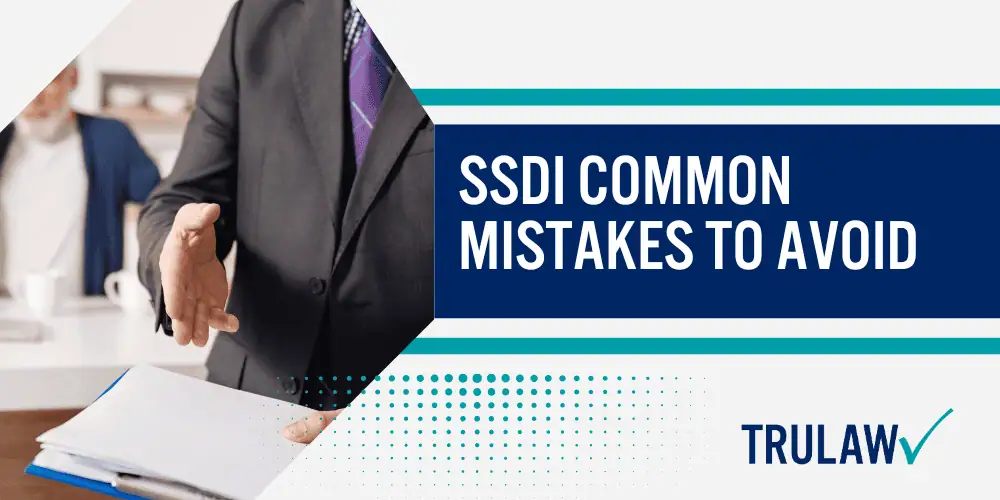
Common errors include submitting incomplete applications, failing to provide adequate medical evidence, and missing important deadlines.
Common Mistakes to Avoid in The SSDI Application Process
Avoiding these common mistakes can make a significant difference in the SSDI application process.
Staying informed, prepared, and proactive throughout your SSDI application process may increase your likelihood of qualifying for SSDI benefits.
Here are some of the most common mistakes made throughout the SSDI application process:
- Collecting Unemployment: Collecting unemployment while applying for SSDI can suggest you are able to work, which may contradict your disability claim.
- Working While Applying: Working while applying for SSDI can signal to the SSA that you are not fully disabled, potentially leading to a denial.
- Not Hiring an SSDI Lawyer: Not hiring an SSDI lawyer can reduce your chances of approval due to a lack of guidance and representation.
- Not Checking Your Claim Status: Failing to check your claim status can result in missed deadlines and delays in your application process.
- Missing the Appeal Deadline: Missing the deadline to appeal a denied claim can force you to restart the entire application process.
- Unprepared for a Disability Hearing: Being unprepared for a disability hearing can negatively affect the outcome of your case.
- Not Taking Prescribed Medication: Not taking medication as prescribed can be viewed as non-compliance, which might harm your disability claim.
- Ignoring Mental Conditions on Application: Not including mental health conditions on your application can lead to an incomplete assessment of your disability.
- Not Seeing a Doctor Regularly: Infrequent medical visits can weaken your claim by failing to provide continuous evidence of your condition.
- Staying with an Unsupportive Doctor: Remaining with a doctor who does not support your claim can reduce the effectiveness of your medical evidence.
By thoroughly preparing your application, seeking professional assistance when needed, and maintaining consistent medical care, you can better position yourself for approval.
Each step you take toward ensuring the accuracy and completeness of your SSDI application brings you closer to securing the benefits you need.
SSDI Application Process
Preparing to file your SSDI application requires careful planning and thorough documentation.
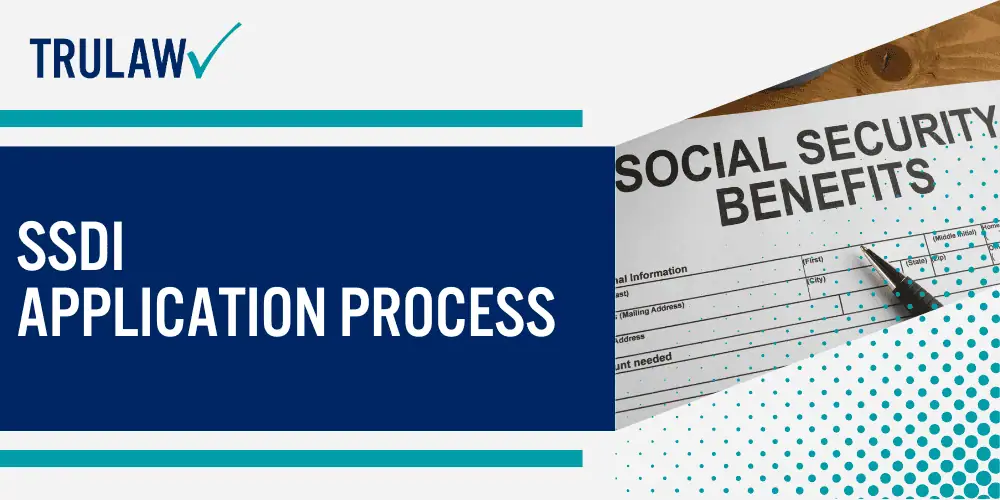
Being well-prepared and organized can help ensure a smooth application process by avoiding common mistakes.
Before beginning the application, you can gather the following records and info to support your claim:
- Basic Contact Info: Ensure all your details, such as your full name, address, phone number, and Social Security number, are accurate and up to date.
- Past Employment Records: Provide a detailed history of your employment, including names of employers, dates of employment, job titles, and a summary of duties and responsibilities.
- Medical Records: Compile all relevant medical records, including diagnoses, treatment plans, medications, and contact information for your healthcare providers.
- Education Records: Include information about your educational background, such as the highest level of education completed and any vocational training or certifications.
Ensuring that you have all this information prepared and well-documented will also help avoid delays in processing your application and provide a stronger basis for your claim.
SSDI Applications: Submission to Final Determination
Once you submit your SSDI application, your claims representative will forward it to the Disability Determination Services (DDS) agency in your state.
At DDS, a claims examiner, in consultation with a DDS doctor, will review your application and request your medical records from your healthcare providers and any hospitals you have visited.
The decision-making process at this stage typically takes four to seven months but can be extended if it is difficult to contact you or obtain your medical records.
After the DDS has reviewed your application, Social Security will mail you a decision.
Approximately 61% of initial claims are denied, but you have the option to request a “reconsideration” within 60 days of receiving the denial.
During reconsideration, a different claims examiner will re-evaluate your file, which can take another four to seven months.
Although around 85% of disabled worker beneficiaries are denied at this stage, this step is necessary to advance to a hearing before a Social Security judge if your claim continues to be rejected.
SSDI Determination Process
The Social Security Disability Insurance (SSDI) determination process involves a thorough review of an applicant’s medical and work history.
The Social Security Administration (SSA) employs a systematic approach to evaluate each claim for disability benefits.
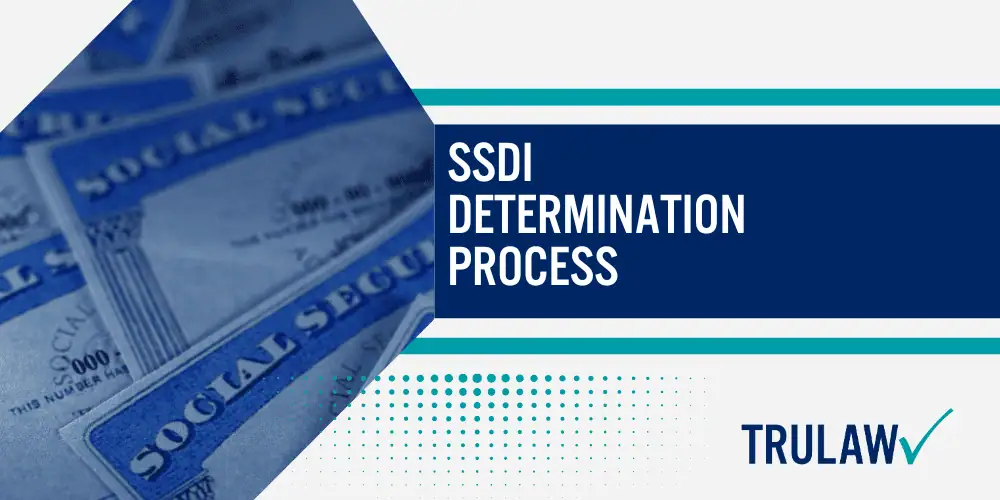
This process ensures that only those who meet the specific criteria receive SSDI benefits.
How Applications Are Reviewed and Evaluated
When your SSDI application is submitted, the SSA first reviews it to ensure that all necessary forms are completed and the required information is provided.
The SSA uses the following five-step process to conduct an initial review:
- Substantial Gainful Activity (SGA) assessment
- Severity of impairment evaluation
- Comparison with the SSA’s “Blue Book” listings
- Ability to perform past work review
- Capacity for alternative work examination
The application is then forwarded to the Disability Determination Services (DDS) agency in your state, where a claims examiner and a DDS medical professional evaluate your claim.
Each step in this process plays a role in determining an applicant’s eligibility for SSDI benefits.
If your application meets all criteria, the DDS will approve your claim, and you will begin receiving benefits.
If your claim is denied, you have the right to appeal the decision, beginning with a request for reconsideration, followed by further appeals if necessary.
SSDI Appeal Process
If your claim for Social Security Disability Insurance (SSDI) or Supplemental Security Income (SSI) benefits has been denied, you have the right to appeal the decision.
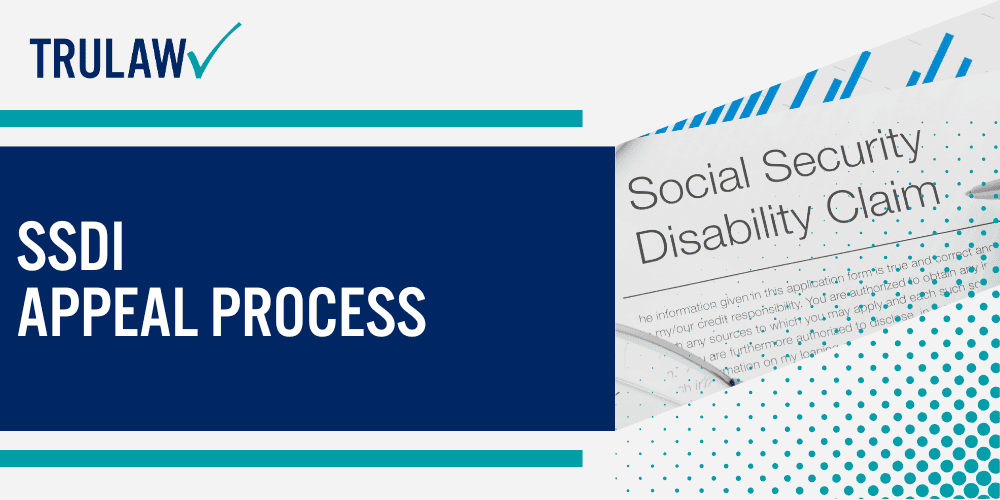
There are four levels of appeal you can pursue if you disagree with the determination made by the Social Security Administration (SSA):
- Reconsideration: This is the first step in the appeal process, where a new examiner reviews your application. This stage does not involve a hearing, and the examiner evaluates your claim based on the existing records as well as any new evidence you provide.
- Hearing by an Administrative Law Judge (ALJ): If your claim is denied at the reconsideration stage, you can request a hearing before an ALJ. This judge is an independent official who will review your case, listen to testimony, and make a new decision based on the law and the evidence presented.
- Review by the Appeals Council: If the ALJ denies your claim, you can request a review by the SSA’s Appeals Council. The Council may deny your request if it believes the hearing decision was correct, or it may choose to review your case and make a new decision, or send it back to an ALJ for further review.
- Federal Court Review: If you disagree with the Appeals Council’s decision, or if the Council decides not to review your case, you have the option to file a lawsuit in a federal district court. This is the final level of appeal, where a federal judge will review the SSA’s decision and determine if it was made according to the law.
The appeal process allows you to challenge both disability-related and non-medical determinations.
Following along with these steps can help you effectively present your case and improve your chances of a successful outcome.
Reconsideration of Initial SSDI Denial
The first step in the SSDI appeal process is requesting a reconsideration of the initial denial.
A reconsideration is a thorough review of your claim conducted by an individual who did not participate in the original decision.
During this review, the examiner will evaluate all the evidence that was initially submitted and consider any new evidence that you or the SSA may provide.
If your appeal involves a decision about whether you have a qualifying disability, the request for reconsideration will be forwarded to the Disability Determination Services (DDS) in your state.
The DDS will handle the review and may contact you if additional information is needed.
If the appeal concerns a non-medical issue, such as an overpayment, the reconsideration will be processed by the SSA’s local office or payment center.
In these cases, a technician may reach out to you for further evidence or clarification regarding your claim.
If the reconsideration decision is still unfavorable, you can proceed to the next level of appeal: a hearing by an administrative law judge.
SSDI Assistance Programs for Applicants
The SSA aims to reduce the wait time for applicants who are most in need of immediate support by streamlining the decision-making process.
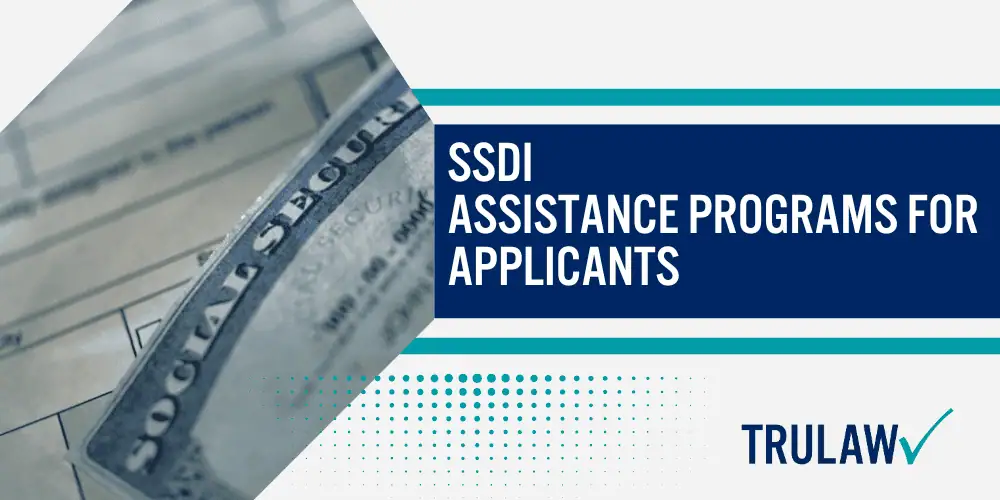
These programs are designed to provide faster access to benefits for those in urgent situations, whether due to severe medical conditions, terminal illness, or extreme financial distress.
Expedited Application Processes
The SSA recognizes that some applicants require immediate assistance due to the severity of their medical conditions or other urgent circumstances.
The SSA’s expedited process programs include:
- Compassionate Allowances (CAL): Expedited processing for applicants with severe medical conditions, identified through a list of qualifying conditions.
- Quick Disability Determinations (QDD): Uses predictive models to fast-track applications likely to be approved based on initial medical evidence.
- Terminal Illness (TERI) Cases: Prioritizes applications for individuals with documented terminal illnesses to fast-track approval.
- Presumptive Disability (PD) and Presumptive Blindness (PB): Temporary benefits granted to applicants with conditions that clearly meet the disability criteria while formal review is conducted.
- Expedited Reinstatement: Allows former SSDI recipients to quickly reinstate benefits if they become disabled again within five years of returning to work.
- Dire Need (DRND) Cases: Expedites processing for applicants facing extreme financial hardship, such as homelessness or inability to afford basic necessities.
Each program targets specific circumstances such as suffering from life-threatening conditions or those unable to afford basic living necessities.
This approach helps mitigate the financial and health-related challenges faced by applicants while waiting for approval.
SSDI Short-term Disability Benefits
Unlike long-term disability benefits provided by Social Security Disability Insurance (SSDI), the federal SSDI program does not cover short-term disabilities.
SSDI is specifically designed to provide benefits to individuals with disabilities expected to last at least one year or result in death.
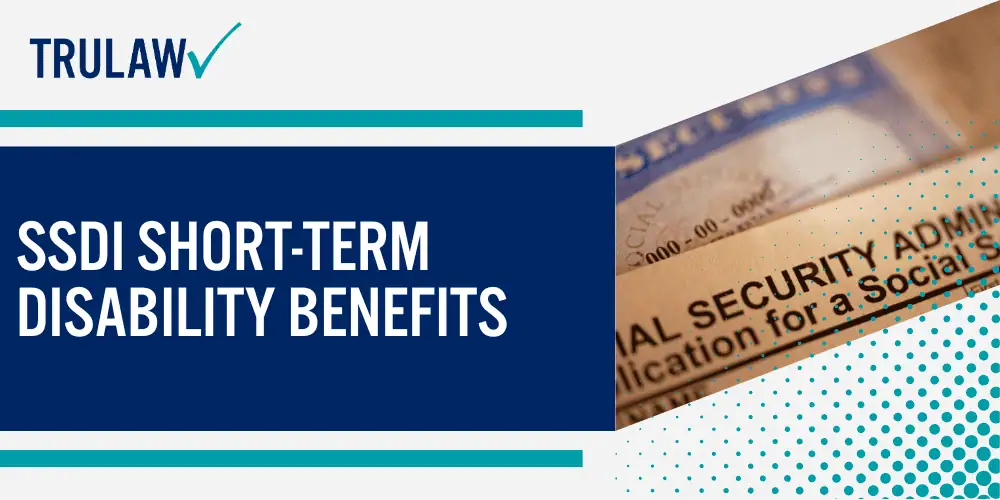
Therefore, applicants who are temporarily disabled for a period shorter than 12 months do not qualify for SSDI.
However, there are ways to bridge this gap using private and state-level short-term disability insurance options.
Bridging the Gap With Private and SSDI Coverage
Since SSDI does not offer short-term disability benefits, many individuals rely on private short-term disability insurance or state programs (where available) to fill the void.
These options can provide income replacement for a temporary disability while you wait for your SSDI application to process or if you do not qualify for SSDI due to the temporary nature of your condition.
These are a few ways to bridge the gap with private and SSDI coverage with short-term disability benefits:
- Private Short-term Disability Insurance: Many employers offer short-term disability insurance as part of their benefits package, which typically provides coverage for a portion of your income if you’re unable to work due to a medical condition.
- State Short-term Disability Programs: Some states, like California, New York, New Jersey, Rhode Island, and Hawaii, provide state-funded short-term disability benefits. These programs vary in duration and eligibility requirements but are designed to provide temporary wage replacement for workers who are unable to work due to a short-term illness or injury.
- Using Both Private and SSDI Coverage: In some cases, individuals may use both private short-term disability and SSDI coverage. For instance, if you experience a medical condition that initially seems temporary but later becomes long-term, your private disability insurance may cover you during the short-term phase, and SSDI can take over once the condition is deemed long-lasting.
Understanding the differences between short-term and long-term disability insurance, as well as exploring available private or state options, can ensure you remain financially stable during periods of illness or injury that don’t meet the SSDI duration criteria.
SSDI Long-term Disability Benefits
SSDI benefits are designed to provide financial support for individuals who are unable to work due to long-term or permanent disabilities.
These benefits are typically meant to last as long as the individual remains disabled and unable to engage in substantial gainful activity (SGA).
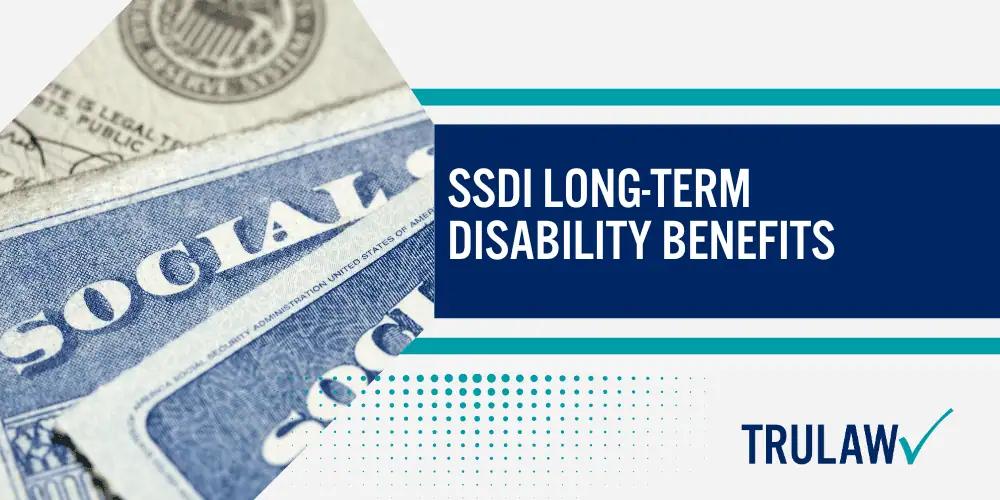
However, maximizing your long-term disability benefits requires careful planning and strategic management of your SSDI and other financial resources.
Maximizing Long-term Disability Benefits
To fully leverage the benefits available through SSDI, it is essential to be aware of strategies that can help increase the overall financial support you receive and ensure long-term stability.
Here are several ways to maximize your SSDI long-term disability benefits:
- Accurate and Detailed Documentation: A critical step in maximizing SSDI benefits is ensuring that your medical records are comprehensive and up to date. Detailed medical documentation supports your case for continued eligibility and may be necessary during periodic reviews conducted by the Social Security Administration (SSA).
- Understand the Impact of Additional Income: While receiving SSDI benefits, you can still earn some income through certain work programs, such as Trial Work Periods or Ticket to Work initiatives, to test your ability to work while still receiving full SSDI benefits for a limited time.
- Combine Private Disability Insurance: Private insurance can provide additional financial support by covering a portion of your income, which, when combined with SSDI, may bring your total benefits closer to your pre-disability income.
- Medicare Eligibility and Maximization: After receiving SSDI benefits for 24 months, you will become eligible for Medicare. Medicare provides health insurance coverage, which can significantly reduce medical expenses.
- Cost-of-Living Adjustments (COLA): SSDI benefits are adjusted annually to keep pace with inflation through Cost-of-Living Adjustments (COLA). Be aware of these adjustments and how they affect your monthly payments.
- Stay Compliant with Continuing Disability Reviews (CDRs): The SSA periodically conducts Continuing Disability Reviews (CDRs) to assess whether your medical condition still qualifies you for SSDI benefits.
By staying informed about the various aspects of SSDI benefits, understanding additional income options, and ensuring that your medical documentation is thorough and current, you can better maximize your long-term financial support through SSDI.
SSDI Taxes and Financial Impact
Receiving Social Security Disability Insurance (SSDI) benefits can have financial implications, particularly when it comes to taxation.
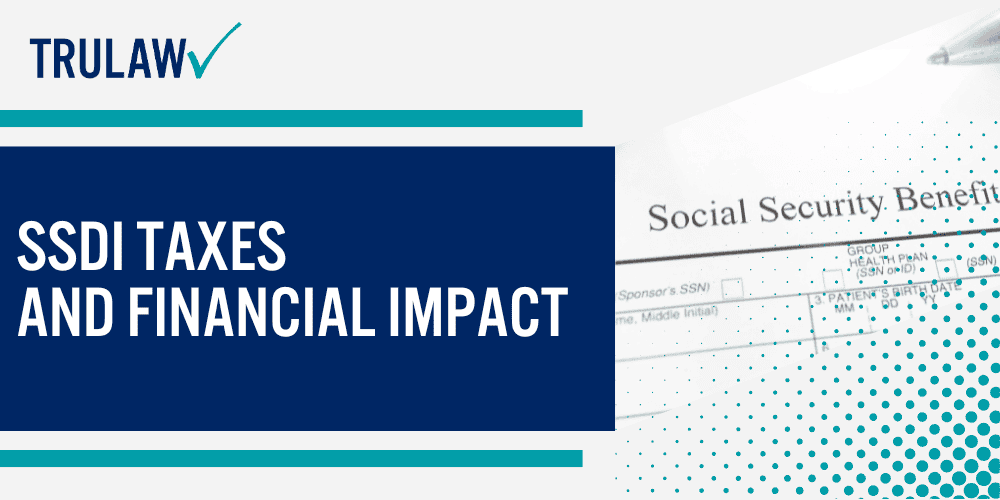
While SSDI payments are generally not subject to federal income tax unless your total household income exceeds a certain threshold, individual states may have different tax rules regarding SSDI benefits.
State Taxation of SSDI Payments
Most states in the U.S. do not tax SSDI benefits, providing significant relief for disabled individuals who rely on these payments as a major source of income.
However, some states do have varying policies on the taxation of SSDI benefits, and it’s essential to understand these rules to properly manage your financial obligations.
- States that Do Not Tax SSDI Payments: The majority of U.S. states exempt SSDI payments from state income taxes. This includes states such as California, Florida, Texas, and New York, where SSDI recipients can receive their benefits without worrying about state income tax deductions
- States That May Tax SSDI Benefits: A few states, such as Minnesota, Colorado, Vermont, and North Dakota, do tax SSDI payments under certain circumstances, often depending on your overall income or whether you meet specific thresholds.
- Partial State Tax Exemptions: Some states, like Nebraska and Connecticut, provide partial exemptions on SSDI benefits. These states may offer deductions or exemptions on a portion of your SSDI benefits based on your total income or filing status.
- Filing Requirements: Whether or not your SSDI benefits are taxable at the state level, you must still report the total amount of SSDI you receive when filing state tax returns in states that tax SSDI.
Stay informed about your state’s tax rules and consult with a tax professional or financial advisor to ensure that you are handling your SSDI benefits correctly.
Understanding the taxation policies that apply to your benefits can help you manage your financial situation effectively and avoid unexpected tax liabilities.
SSDI Legal Help and Resources
Online resources such as this article offers comprehensive information on SSDI and SSI benefits.
TruLaw provides applicants with an online case evaluation using the chat on this page.
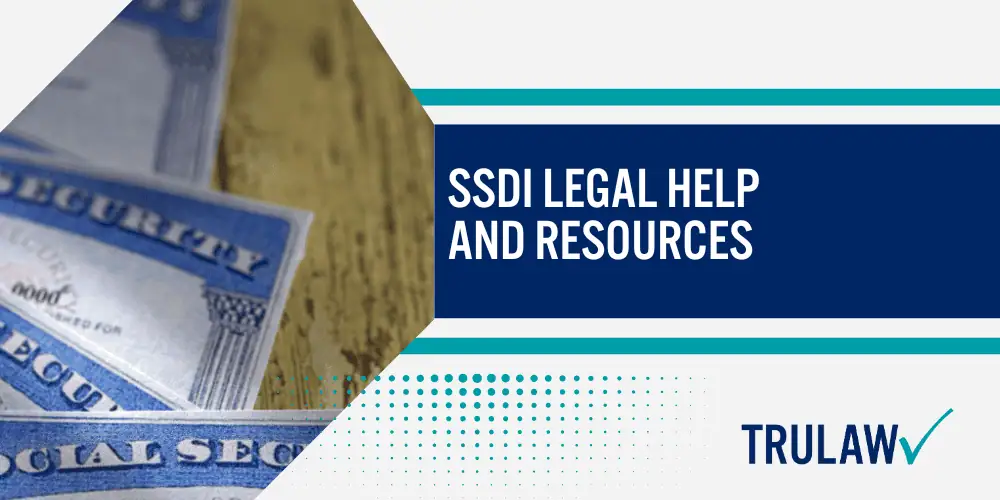
The Social Security Administration (SSA) also offers official information and assistance through their website, including details on the SSI application process.
When to Hire an SSDI Attorney
Hiring an SSDI lawyer or SSDI attorney early in the process can substantially improve your chances of approval for disability benefits.
Ideally, you should consider hiring an attorney before starting your application.
This proactive approach allows the lawyer to guide you through the entire process from the beginning,
If your initial application is denied, it becomes even more important to seek legal representation.
The appeals process involves multiple stages and specific requirements that an experienced SSDI attorney can help you manage effectively.
At this stage, an SSDI lawyer can:
- Guide you through the appeals process
- Represent you at hearings
- Strengthen your case with additional evidence
- Increase your chances of approval
Hiring an SSDI attorney, whether at the beginning of your application or after a denial, can provide valuable expertise and support throughout your claim.
These legal professionals specialize in disability law and understand the Social Security Administration’s requirements.
Their knowledge and experience can be instrumental in helping you secure the benefits you need and deserve.
SSDI Veterans Disability Benefits
The Social Security Disability Insurance (SSDI) program provides financial support for veterans who have paid into the Social Security system through employment and payroll taxes.
Veterans are eligible for SSDI if they have a qualifying disability and meet specific work credit requirements that depend on their age and years of employment.
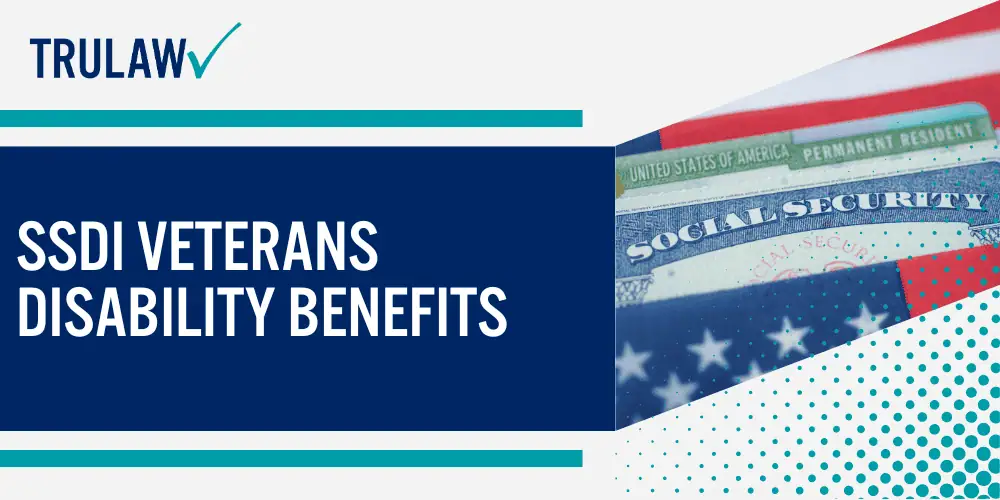
As of 2024, the range of monthly SSDI benefits is between $100 and $3,822.
Special SSDI Rules for Veterans
The SSDI program functions independently from VA disability compensation, allowing veterans to receive benefits from both without any interference between the two.
It is important for veterans to be aware of the need to apply separately for each program to ensure they receive the full entitlements available to them.
A few key details of veteran disability benefits include:
- SSDI and VA benefits do not affect each other.
- Veterans must apply for SSDI and VA benefits independently.
- SSDI benefits for veterans typically ranges from $100 to $3,822 per month.
The application process involves submitting documentation that verifies both the disability and work history for veterans seeking SSDI benefits.
The Social Security Administration has provisions to expedite claims for veterans who sustained disabilities during active military service on or after October 1, 2001.
This prioritization helps veterans receive the support they need in a timely manner.
Additionally, while SSDI is unaffected by VA benefits, veterans should be mindful that VA compensation can impact Supplemental Security Income (SSI), because SSI considers VA benefits as unearned income.
SSDI & Workers Compensation
Social Security Disability Insurance (SSDI) and Workers’ Compensation are two distinct programs that provide financial support to individuals unable to work due to disability or work-related injuries.
In some cases, receiving Workers’ Compensation may reduce SSDI benefits, or vice versa.
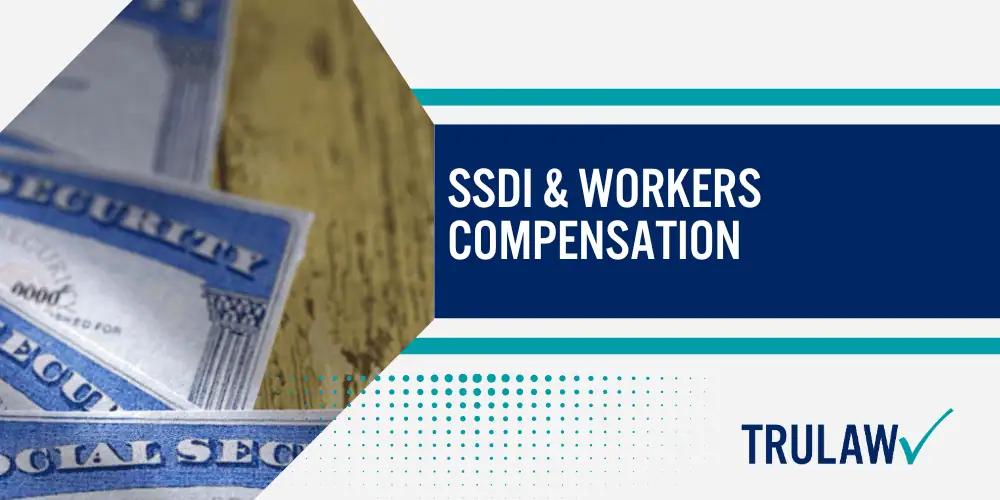
However, certain expenses related to pursuing a Workers’ Compensation claim, such as legal or medical costs, may be considered “excludable” and not impact benefit calculations.
Coordinating Workers Compensation with SSDI Benefits
The interplay between workers’ compensation and Social Security Disability Insurance (SSDI) benefits requires careful consideration to maximize support for individuals with disabilities.
While both programs aim to provide financial assistance to those unable to work due to injury or disability, their coordination involves specific mechanisms and calculations to ensure fair benefit allocation.
Key aspects of coordinating these benefits include:
- The offset mechanism
- Calculating maximum allowable combined benefits
- Eligibility criteria for both programs
- Application processes and timing
- Coordination with other benefit programs
Professional assistance from legal experts or disability advocates can be invaluable when managing the coordination of workers’ compensation and SSDI benefits.
These professionals can help individuals and their family members comprehend the nuances of the offset calculation, guide them through the application processes, and ensure they receive the most advantageous combination of benefits possible.
Additionally, they can assist in coordinating these benefits with other potential sources of support, such as Veterans Affairs (VA) benefits, to create a comprehensive financial safety net for those facing work-related disabilities.
Working While on SSDI
Social Security Disability Insurance (SSDI) is designed for individuals who are unable to engage in substantial gainful activity (SGA) due to a medical condition.
However, many beneficiaries wish to attempt returning to work while maintaining their SSDI benefits.
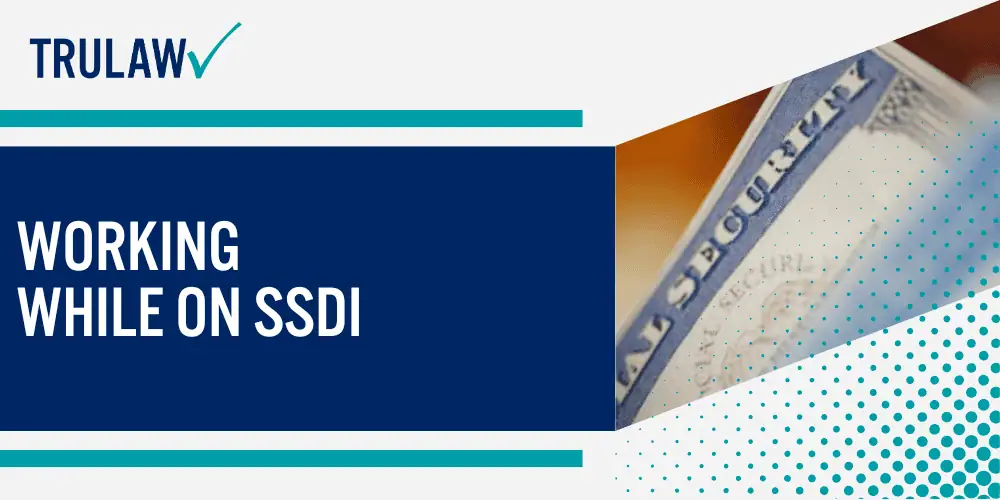
The Social Security Administration (SSA) offers several programs that allow individuals to work and still receive SSDI benefits, as long as they stay within certain guidelines.
Maintaining SSDI Eligibility
- Trial Work Period (TWP): The Trial Work Period allows SSDI beneficiaries to test their ability to return to work without losing their benefits. During the TWP, you can work for nine months (which do not have to be consecutive) while still receiving full SSDI payments, regardless of how much you earn.
- Extended Period of Eligibility (EPE): After the Trial Work Period, the Extended Period of Eligibility lasts for 36 months. During this time, you can still receive SSDI payments for any month in which your earnings do not exceed the Substantial Gainful Activity (SGA) limit, which is $1,550 per month for disabled workers and $2,590 for blind individuals in 2024.
- Expedited Reinstatement: If your SSDI benefits stop because you exceeded the SGA limit but your disability prevents you from continuing to work, you can apply for Expedited Reinstatement. This allows you to regain your SSDI benefits without having to go through the full application process again.
- Ticket to Work Program: The SSA’s Ticket to Work program offers free employment support services to SSDI beneficiaries who want to attempt returning to work.
- Reporting Work Activity: It’s essential to report any changes in work activity to the SSA, including new employment, changes in work hours, or increases in earnings.
By utilizing these programs, SSDI beneficiaries can attempt to return to work while maintaining their eligibility for benefits.
Staying within the income limits and following the reporting requirements ensures that you can work without jeopardizing your SSDI payments.
SSDI Benefits Management Tips
Managing your Social Security Disability Insurance (SSDI) benefits effectively is crucial to ensuring long-term financial stability.
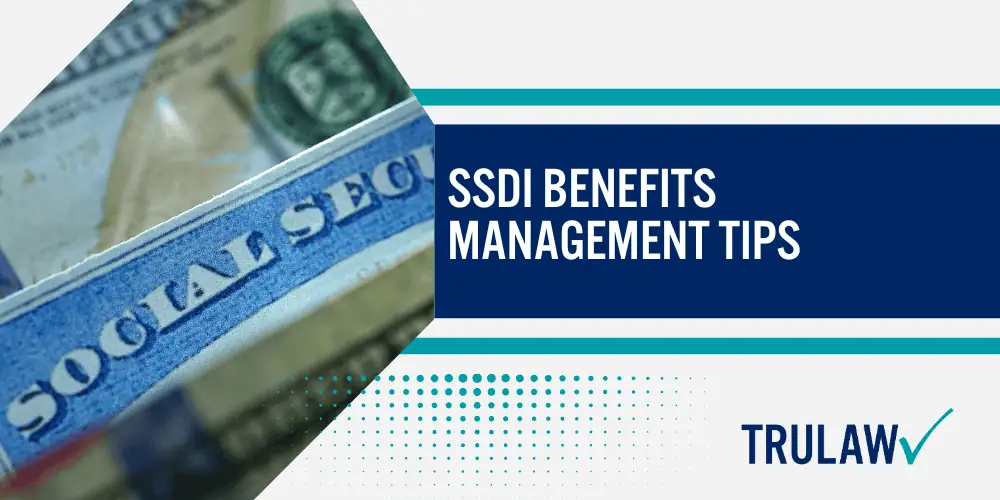
There are several factors to consider, from understanding the rules about working while on SSDI to preparing for changes in your benefits due to cost-of-living adjustments (COLA), income, or medical reviews.
Planning for SSDI Changes
The Social Security Disability Insurance (SSDI) program is poised for potential modifications in the coming years.
President Biden’s proposed $1.3 billion increase to the Social Security Administration’s discretionary budget for fiscal year 2025 could enhance SSDI services and administration.
Here are a few tips to help you plan for SSDI changes:
- Continuing Disability Reviews (CDR) : The SSA periodically reviews disability cases through CDR to determine if beneficiaries continue to meet the eligibility criteria. These reviews typically happen every three to seven years, depending on the nature of your condition.
- Changes in Work Activity: If you are considering returning to work, it’s essential to understand how this can impact your SSDI benefits. The Trial Work Period (TWP) allows you to test your ability to work without losing your benefits, but after this period, you must be cautious about exceeding the Substantial Gainful Activity (SGA) limits.
- Tax Planning: Depending on your total income, your SSDI benefits may be subject to federal taxation. If you have additional sources of income, such as from a spouse or investments, you may need to set aside funds for tax obligations.
- Savings and Budgeting: While SSDI benefits provide essential financial support, it is critical to budget carefully to ensure that you meet your living expenses.
By proactively managing your SSDI benefits and planning for potential changes, you can ensure a smoother experience and maintain the financial support you need.
Regularly reviewing your situation and staying informed about benefit regulations will help you make informed decisions that maximize your benefits.
TruLaw: Your Social Security Disability Insurance (SSDI) Law Firm
At TruLaw, we understand the challenges you face when dealing with a disability that prevents you from working.
Whether you’re just starting your application, facing a denial, or preparing for an appeal, the SSDI lawyers at TruLaw and our partnering law firms are here to help.
If you or a loved one has a mental or physical impairment preventing you from performing substantially gainful activity, you may qualify for SSDI benefits.
In the event your SSDI application has been denied, TruLaw may be able to assist with your SSDI appeal to get you the benefits you are entitled to.
Contact TruLaw using the chat on this page to receive an instant case evaluation and determine your eligibility to file or appeal your SSDI benefits claim.
Social Security Disability Insurance Frequently Asked Questions
-
SSDI recipients are allowed to work while receiving benefits, but their earnings must not exceed the Substantial Gainful Activity (SGA) limit set by the Social Security Administration.
Exceeding the SGA limit (which is $1,550 per month for disabled applicants and $2,590 per month for blind applicants) may result in a cessation of SSDI benefits.
-
First-time SSDI applicants should gather all necessary medical documentation and work history information before beginning the application process.
It’s also helpful to consult with an experienced SSDI representative who can guide you through the process and help you avoid common pitfalls.
Contact TruLaw using the chat on this page to receive an instant case evaluation to qualify for SSDI benefits today.
-
During the SSDI trial work period, recipients can test their ability to work for at least nine months without losing their benefits.
However, it’s important to report all earned income to the Social Security Administration to avoid potential penalties or overpayments.
-
State laws and regulations do not directly affect Social Security Disability Insurance (SSDI) benefits, as SSDI is a federal program governed by federal laws.
However, individual states may have additional disability programs, such as State Disability Insurance (SDI) or Medicaid, which can interact with SSDI benefits.
The state in which you live can also affect the availability of state-specific resources, assistance programs, and the processing times for SSDI applications.
-
To qualify for Social Security Disability Insurance (SSDI), the Social Security Administration (SSA) requires you to provide comprehensive medical evidence of a disability that prevents you from working.
This includes detailed medical records, doctors’ reports, diagnostic test results, and any other relevant documentation that demonstrates the severity and duration of your condition.

Managing Attorney & Owner
With over 25 years of legal experience, Jessica Paluch-Hoerman is an Illinois lawyer, a CPA, and a mother of three. She spent the first decade of her career working as an international tax attorney at Deloitte.
In 2009, Jessie co-founded her own law firm with her husband – which has scaled to over 30 employees since its conception.
In 2016, Jessie founded TruLaw, which allows her to collaborate with attorneys and legal experts across the United States on a daily basis. This hypervaluable network of experts is what enables her to share the most reliable, accurate, and up-to-date legal information with our readers!
Additional Social Security Disability Insurance resources on our website:
Here, at TruLaw, we’re committed to helping victims get the justice they deserve.
Alongside our partner law firms, we have successfully collected over $3 Billion in verdicts and settlements on behalf of injured individuals.
Would you like our help?
At TruLaw, we fiercely combat corporations that endanger individuals’ well-being. If you’ve suffered injuries and believe these well-funded entities should be held accountable, we’re here for you.
With TruLaw, you gain access to successful and seasoned lawyers who maximize your chances of success. Our lawyers invest in you—they do not receive a dime until your lawsuit reaches a successful resolution!
AFFF Lawsuit claims are being filed against manufacturers of aqueous film-forming foam (AFFF), commonly used in firefighting.
Claims allege that companies such as 3M, DuPont, and Tyco Fire Products failed to adequately warn users about the potential dangers of AFFF exposure — including increased risks of various cancers and diseases.
Depo Provera Lawsuit claims are being filed by individuals who allege they developed meningioma (a type of brain tumor) after receiving Depo-Provera birth control injections.
A 2024 study found that women using Depo-Provera for at least 1 year are five times more likely to develop meningioma brain tumors compared to those not using the drug.
Suboxone Tooth Decay Lawsuit claims are being filed against Indivior, the manufacturer of Suboxone, a medication used to treat opioid addiction.
Claims allege that Indivior failed to adequately warn users about the potential dangers of severe tooth decay and dental injuries associated with Suboxone’s sublingual film version.
Social Media Harm Lawsuits are being filed against social media companies for allegedly causing mental health issues in children and teens.
Claims allege that companies like Meta, Google, ByteDance, and Snap designed addictive platforms that led to anxiety, depression, and other mental health issues without adequately warning users or parents.
Transvaginal Mesh Lawsuits are being filed against manufacturers of transvaginal mesh products used to treat pelvic organ prolapse (POP) and stress urinary incontinence (SUI).
Claims allege that companies like Ethicon, C.R. Bard, and Boston Scientific failed to adequately warn about potential dangers — including erosion, pain, and infection.
Bair Hugger Warming Blanket Lawsuits involve claims against 3M — alleging their surgical warming blankets caused severe infections and complications (particularly in hip and knee replacement surgeries).
Plaintiffs claim 3M failed to warn about potential risks — despite knowing about increased risk of deep joint infections since 2011.
Baby Formula NEC Lawsuit claims are being filed against manufacturers of cow’s milk-based baby formula products.
Claims allege that companies like Abbott Laboratories (Similac) and Mead Johnson & Company (Enfamil) failed to warn about the increased risk of necrotizing enterocolitis (NEC) in premature infants.
Here, at TruLaw, we’re committed to helping victims get the justice they deserve.
Alongside our partner law firms, we have successfully collected over $3 Billion in verdicts and settlements on behalf of injured individuals.
Would you like our help?
